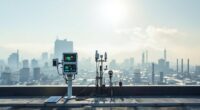Water monitoring involves systematically checking water bodies’ health through physical, chemical, and biological parameters. Methods range from simple grab sampling to sophisticated continuous monitoring using automated systems. Equipment includes basic probes measuring pH and temperature, spectrophotometers identifying chemicals, and automated samplers collecting water continuously. Data analysis transforms these measurements into meaningful narratives through statistical analysis and GIS mapping. This thorough approach helps protect aquatic ecosystems and human health, offering early warnings when water quality shifts.

Countless gallons of water flow through our rivers, lakes, and aquifers every day, yet understanding what’s actually in that water requires far more than just a casual glance. Water monitoring—the science of systematically sampling and analyzing water bodies—serves as our aquatic detective, revealing the hidden story beneath the surface. Think of it as nature’s health check-up, essential for safeguarding both human communities and the critters calling these waters home.
The monitoring toolkit starts with measuring key parameters—the crucial indicators of water health. Physical characteristics like turbidity (water’s cloudiness, not its emotional state) and temperature set the stage. Chemical factors such as pH and dissolved oxygen tell us whether fish are living in a comfortable aquatic condo or a stressful underwater studio apartment. Biological indicators—from microscopic bacteria to bottom-dwelling insects—act as nature’s sentinels in the coal mine, alerting us to trouble before our instruments can.
Water’s vital signs reveal all: cloudiness, chemistry, and critters telling the real story of what swims beneath the surface.
Collection methods vary depending on what story we’re trying to uncover. Grab sampling is like taking a snapshot—useful but limited to a moment in time. Composite sampling, meanwhile, blends multiple samples for the highlight reel of water conditions. For the full-length feature film, continuous monitoring with automated sensors provides the 24/7 coverage water managers crave.
The equipment arsenal ranges from simple probes that measure basic parameters to sophisticated spectrophotometers that identify chemicals with CSI-level precision. Automated samplers work like tireless interns, collecting samples day and night without complaint or coffee breaks. Water quality assessments often include analyzing electrical conductivity to determine ion concentration and potential contamination sources.
Once collected, data transforms from numbers into narratives through statistical analysis and comparison to established standards. GIS mapping turns spreadsheets into visual stories, showing how water quality changes across landscapes. Quality control measures guarantee these stories are non-fiction rather than fantasy.
The payoff? Clean drinking water, thriving ecosystems, and the early warning systems needed to protect our most precious resource. Reviewing baseline water quality data helps evaluate the origin of contaminants and informs effective management strategies. In a world where water challenges grow daily, monitoring provides the knowledge needed for informed decisions—turning facts into action.
Frequently Asked Questions
How Often Should Water Monitoring Equipment Be Calibrated?
Calibration frequency for water monitoring equipment varies based on several factors. Most dissolved oxygen sensors need daily calibration, while pH meters require weekly to monthly checks. Turbidity meters typically need quarterly calibration, and conductivity meters annual attention.
Equipment type, manufacturer recommendations, regulatory requirements, environmental conditions, and usage intensity all influence the schedule. Industries like pharmaceutical manufacturing demand more frequent calibration than environmental monitoring. Best practice involves developing a documented schedule using certified reference materials.
Can Citizen Scientists Contribute Meaningfully to Water Quality Monitoring?
Citizen scientists absolutely contribute meaningful water quality data. Through proper training, they expand monitoring networks to previously uncovered areas, collecting more frequent samples than professionals alone could manage. While their methods may lack laboratory precision, standardized protocols guarantee reliability.
Beyond data collection, these volunteer efforts foster environmental stewardship in communities, raise public awareness about water issues, and create powerful bridges between scientific institutions and local populations.
What’s the Cost Range for Basic Water Monitoring Equipment?
Basic water monitoring equipment spans a wide price range. Simple test kits cost $10-$50 for single parameters, while multi-parameter kits run $50-$200 depending on testing capabilities.
Stepping up to handheld meters and probes pushes the budget to $200-$2,000, with professional multi-parameter devices reaching $12,000+. Laboratory equipment starts around $300 for basic scales and climbs to $10,000 for advanced analyzers. Cost factors include precision requirements, parameter range, and ongoing maintenance needs.
How Do Seasonal Changes Affect Water Monitoring Results?
Seasonal changes greatly impact water monitoring results through multiple pathways. Temperature fluctuations affect dissolved oxygen levels and chemical reaction rates.
Precipitation patterns influence runoff intensity, introducing varying contaminants like agricultural chemicals during spring thaw or concentrating pollutants during dry periods.
Biological activity shifts seasonally, with summer algal blooms affecting water quality parameters. These variations require adjustments in monitoring frequency, equipment calibration, and interpretation of results to distinguish seasonal patterns from long-term trends.
Which Water Parameters Matter Most for Specific Industries?
Different industries prioritize specific water parameters based on their unique needs. Manufacturing focuses on pH, conductivity, and dissolved oxygen to prevent corrosion.
Food and beverage industries monitor chlorine, TDS, and alkalinity for product quality. Power generation tracks silica, ammonia, and dissolved gases to protect equipment. Pharmaceuticals emphasize endotoxin levels, TOC, and microbial counts for safety compliance.
Understanding these industry-specific requirements helps facilities implement targeted monitoring systems that safeguard equipment, certify product quality, and maintain regulatory compliance.









